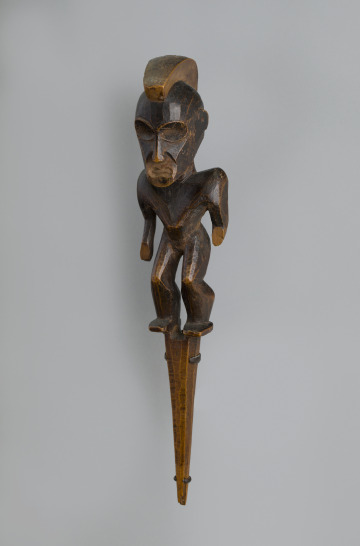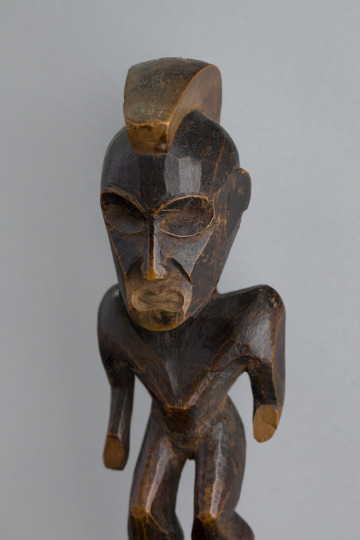Figure (akua ka’ai)
- Artist Culture
- Hawaiian artist
- Date
- 18th century
- Material
- Wood, pigment
- associated with
- Hawaii, Polynesia, United States, Oceania
- Classification
- Sculpture, wood
- Current Location
- On View, Gallery 108
- Dimensions
- 12 1/16 x 2 1/2 in. (30.7 x 6.3 cm)
- Credit Line
- Bequest of Morton D. May
- Rights
- Contact Us
- Object Number
- 1532:1983
NOTES
Regular, geometric, and forthright volumes confer great monumentality upon this diminutive figure. This expansive design structure is characteristic of Polynesian sculpture and achieves some of its most successful expressions in Hawaiian art. The group of known sculptures similar to this one is limited to around 40 works; they are recognizable for the small figure atop a pointed, elongated shaft. Although their precise role is undocumented, they are called akua ka’ai, or divinity sculptures, and were placed in ceremonial enclosures. Sometimes also referred to as “god sticks,” they would have been planted in the earth, positioned on altars, or located in the rafters, thatched roofs, or walls inside temples.
Provenance
Boulter Collection [1]
1850 - 1870
Richard Cuming (1777-1870), London, England [2]
1870 - 1902
H. Syer Cuming (d.1902), London, England, by inheritance [3]
1902 – c. 1946
Cuming Museum, London, England [4]
c. 1946 - 1948
Kenneth A. Webster, London, England, acquired from the Cuming Museum [5]
1948 - 1977
James Thomas Hooper (1897-1971), England, acquired from Kenneth A. Webster; Estate of James Thomas Hooper [6]
1977 - 1983
Morton D. May (1914-1983), St. Louis, MO, USA, purchased at auction of “Hawaiian and Maori Art from the James Hooper Collection,” Christie, Manson and Woods, London, June 21, 1977, lot no. 185 [7]
1983 -
Saint Louis Art Museum, bequest of Morton D. May [8]
Notes:
The main source for this provenance is a 1979 exhibition catalog [Kaeppler, Adrienne L. "Eleven Gods Assembled: An Exhibition of Hawaiian Wooden Images." Honolulu: Bishop Museum Press, 1979, p. 14]. Exceptions and other supporting documents are noted.
[1] The piece is inscribed on the back in black ink "Sandwich Is. Got from Mr. Boulter." Mr. Boulter was probably Daniel Boulter of Yarmouth, England, owner of a museum/shop at the end of the 18th century and possessor of many pieces collected by Cook on his voyages.
[2] Richard Cuming was an amateur scientist and collector. According to Cuming's manuscript catalog (quoted by Kaeppler), he purchased the piece on July 6, 1850. Kaeppler suggests that Cuming may have purchased the piece from Mr. Boulter or his descendants, or from an intermediate unknown owner.
[3] H. Syer Cuming was the son of Richard Cuming.
[4] The Cuming Museum was established by will of H. Syer Cuming in 1902. From 1930 to 1948 the museum was closed and was bombed with fire-bombs in World War II. During this period, a number of important ethnographic artifacts entered the collection of Kenneth A. Webster.
[5] See Note [4]. In an email dated March 5, 2001 from Steven Hooper to Michael Gunn, curator at the Saint Louis Art Museum, Hooper stated “Kenneth Webster got…that around 1946 and several other Polynesian things from the [Cuming] museum, which he then swapped with my grandfather [James T. Hooper]” [copy of email in SLAM document files].
[6] James Hooper acquired the piece in 1948 from Kenneth A. Webster ["Hawaiian and Maori Art from the late James T. Hooper's Collection." Christie, Manson and Woods, London, June 21, 1977, p. 54]. This object was No. 271 in the Hooper Collection [Phelps, Steven. Art and Artefacts of the Pacific, Africa and the Americas: The James Hooper Collection. London: Hutchinson and Company, 1976]. In an email dated February 22, 2012 from Steven Hooper to Amy Clark of the Saint Louis Art Museum, Hooper stated “after my grandfather died in 1971 the entire collection belonged to his estate, “The Estate of James Thomas Hooper,” until items were sold at the series of auctions.” [copy of email in SLAM document files].
[7] See Note [6]. An invoice dated June 21, 1977 from Christie, Manson and Woods to Morton D. May documents the purchase of this object [May Archives, Saint Louis Art Museum].
[8] Last Will and Testament of M. D. May dated June 11, 1982 [copy, May Archives, Saint Louis Art Museum]. Minutes of the Acquisitions and Loans Committee of the Board of Trustees, Saint Louis Art Museum, September 20, 1983.
1850 - 1870
Richard Cuming (1777-1870), London, England [2]
1870 - 1902
H. Syer Cuming (d.1902), London, England, by inheritance [3]
1902 – c. 1946
Cuming Museum, London, England [4]
c. 1946 - 1948
Kenneth A. Webster, London, England, acquired from the Cuming Museum [5]
1948 - 1977
James Thomas Hooper (1897-1971), England, acquired from Kenneth A. Webster; Estate of James Thomas Hooper [6]
1977 - 1983
Morton D. May (1914-1983), St. Louis, MO, USA, purchased at auction of “Hawaiian and Maori Art from the James Hooper Collection,” Christie, Manson and Woods, London, June 21, 1977, lot no. 185 [7]
1983 -
Saint Louis Art Museum, bequest of Morton D. May [8]
Notes:
The main source for this provenance is a 1979 exhibition catalog [Kaeppler, Adrienne L. "Eleven Gods Assembled: An Exhibition of Hawaiian Wooden Images." Honolulu: Bishop Museum Press, 1979, p. 14]. Exceptions and other supporting documents are noted.
[1] The piece is inscribed on the back in black ink "Sandwich Is. Got from Mr. Boulter." Mr. Boulter was probably Daniel Boulter of Yarmouth, England, owner of a museum/shop at the end of the 18th century and possessor of many pieces collected by Cook on his voyages.
[2] Richard Cuming was an amateur scientist and collector. According to Cuming's manuscript catalog (quoted by Kaeppler), he purchased the piece on July 6, 1850. Kaeppler suggests that Cuming may have purchased the piece from Mr. Boulter or his descendants, or from an intermediate unknown owner.
[3] H. Syer Cuming was the son of Richard Cuming.
[4] The Cuming Museum was established by will of H. Syer Cuming in 1902. From 1930 to 1948 the museum was closed and was bombed with fire-bombs in World War II. During this period, a number of important ethnographic artifacts entered the collection of Kenneth A. Webster.
[5] See Note [4]. In an email dated March 5, 2001 from Steven Hooper to Michael Gunn, curator at the Saint Louis Art Museum, Hooper stated “Kenneth Webster got…that around 1946 and several other Polynesian things from the [Cuming] museum, which he then swapped with my grandfather [James T. Hooper]” [copy of email in SLAM document files].
[6] James Hooper acquired the piece in 1948 from Kenneth A. Webster ["Hawaiian and Maori Art from the late James T. Hooper's Collection." Christie, Manson and Woods, London, June 21, 1977, p. 54]. This object was No. 271 in the Hooper Collection [Phelps, Steven. Art and Artefacts of the Pacific, Africa and the Americas: The James Hooper Collection. London: Hutchinson and Company, 1976]. In an email dated February 22, 2012 from Steven Hooper to Amy Clark of the Saint Louis Art Museum, Hooper stated “after my grandfather died in 1971 the entire collection belonged to his estate, “The Estate of James Thomas Hooper,” until items were sold at the series of auctions.” [copy of email in SLAM document files].
[7] See Note [6]. An invoice dated June 21, 1977 from Christie, Manson and Woods to Morton D. May documents the purchase of this object [May Archives, Saint Louis Art Museum].
[8] Last Will and Testament of M. D. May dated June 11, 1982 [copy, May Archives, Saint Louis Art Museum]. Minutes of the Acquisitions and Loans Committee of the Board of Trustees, Saint Louis Art Museum, September 20, 1983.



